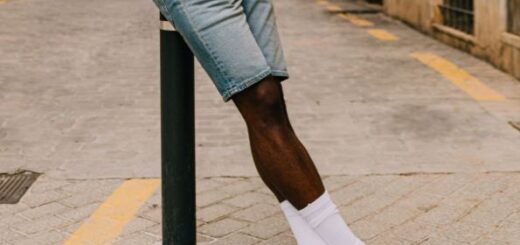How to Wear Boots to the Office: A Modern Gentleman’s Guide
In many professional circles, boots have long been considered weekend attire or something to wear in inclement weather. But that mindset is shifting. Today, boots can hold their own in office environments that range from strictly corporate to creative and casual. The secret? Picking the right styles and pairing them properly.
Gone are the days when Oxfords ruled every boardroom. Smart boots are not only acceptable—they’re often preferred for their versatility, character, and comfort. If you’re ready to elevate your work wardrobe, this comprehensive guide will walk you through the art of wearing boots at the office, no matter your dress code.
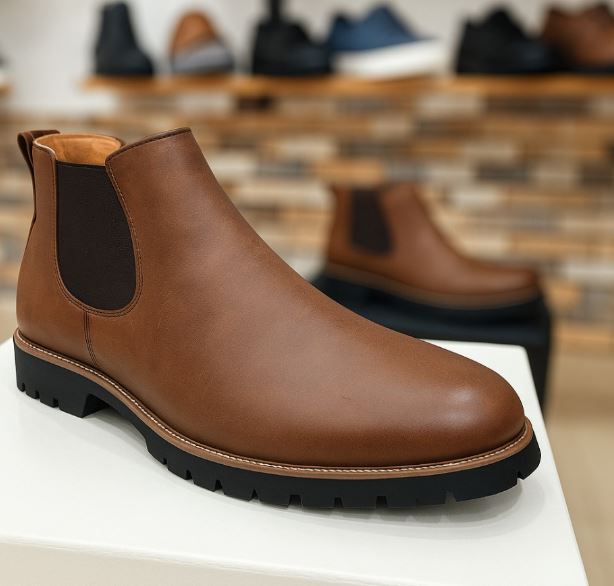
Transitioning from Oxfords to Boots
If you’ve always worn traditional dress shoes, the idea of boots might feel like a leap. But in reality, ankle boots—especially those with sleek silhouettes—offer the same polish, with added comfort and durability. A well-designed Chelsea or lace-up boot can look just as sharp as your favorite brogues, provided you pay attention to cut, finish, and proportion.
One word of advice before you dive in: give your boots a break between wears. Leather needs time to air out and recover from daily moisture. Rotating between pairs not only prolongs their lifespan but also gives you more styling options throughout the week.
Boots and Suits: A Seamless Pairing
Boots and suits make a powerful duo—when styled correctly. The key is to keep everything streamlined. Ankle-height boots with minimal bulk work best under suit trousers. Chelsea boots, with their clean lines and side gussets, are ideal for formal attire. If you prefer laces, go for slim lace-up boots with a refined silhouette.
Avoid rugged outsoles or thick treads—those are better left for weekends. Stick to polished leather or subtle suede in dark shades for a look that blends seamlessly into the professional world.
How to Pick the Right Boot Shape
Just like with dress shoes, boot shape affects formality. A chiselled toe appears more elegant and pairs well with tailored pieces. Round toes feel more casual and suit business-casual outfits or relaxed tailoring. When dressing for the office, always consider the shape of the toe and the taper of the ankle.
Wearing Black Boots with Black Suits
For the most formal occasions, black boots are your best bet. With black suits, opt for a sleek black Chelsea boot or slim black lace-up boot. The aim is to keep the silhouette cohesive. Avoid styles with chunky soles or distressed leather. Ensure your trousers are cut long enough to cover the top of the boot for a cleaner line—visible socks can disrupt the look.
Styling Grey Suits with Boots
Grey suits offer more flexibility than black, opening the door for brown or even tan boots depending on the shade. A dark grey suit looks especially refined with chocolate brown boots, while lighter greys pair well with caramel tones. For modern offices, this is your chance to add variety while staying polished. Choose leather boots with a subtle shine or minimal stitching to keep things sharp.
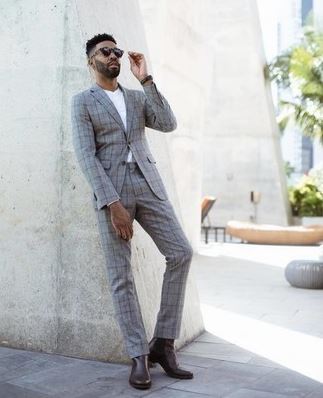
Pairing Blue Suits with Boots
Navy suits are among the most versatile in a man’s closet—and they pair beautifully with a wide range of boots. Rich brown or tan boots complement navy exceptionally well, but you can also try suede in complementary tones. For a more relaxed take, skip the tie and add texture through your footwear. Suede Chelsea boots or softly worn leather chukkas offer a refreshing change from rigid formality.
Embracing Patterns with Confidence
Patterned suits—think checks, plaids, or pinstripes—allow for a bit more experimentation. Try pairing a textured boot with a windowpane or herringbone suit. The contrast between the tailored pattern and a slightly rugged boot creates visual interest. Just avoid overcomplicating things; if your suit is loud, keep your boots understated. A simple dark brown leather boot with a clean finish works best.
Office Boots for Smart Casual Days
Not every office calls for a full suit. In environments with a smart casual dress code, boots are often the most appropriate footwear choice. Chelsea boots, desert boots, and suede chukkas all offer comfort and elegance without looking too relaxed.
Pair your boots with slim chinos, tailored denim, or wool trousers. Avoid ultra-tight pants that cling to your calves—boots need a little breathing room. A small break at the hem keeps the outfit balanced and elongates your silhouette.
Choosing Chukka and Lace-Up Boots
Chukka boots bring a relaxed sophistication that works well for open-plan offices and creative industries. Leather or suede versions in brown or tan are incredibly versatile. You can pair them with a tucked-in button-up shirt and chinos or layer them under wool trousers with a crewneck sweater.
Lace-up boots, on the other hand, should be kept sleek. Avoid heavy-duty combat styles. Look for polished leather, a slim profile, and minimal hardware. These can be a great alternative to derbies on colder days.
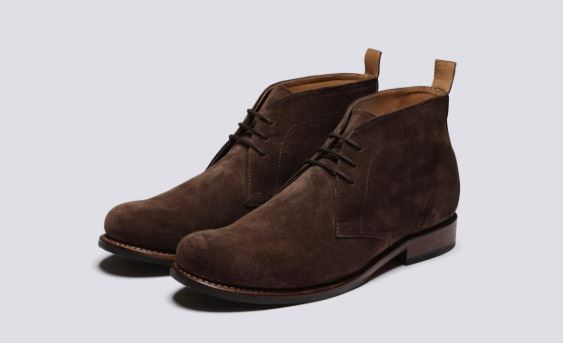
Matching Boot Colors with Your Wardrobe
When it comes to choosing boot colors, stick to basic tones that complement your existing workwear. Here’s a quick breakdown to keep in mind:
Black Boots
Best suited for formal environments and monochromatic wardrobes. They go well with black, charcoal, and navy suits. However, they may look too stark against lighter trousers like beige or olive chinos.
Brown Boots
More versatile and slightly less formal than black. Perfect for grey suits, navy tailoring, and all shades of chinos. Dark brown works best for formal looks, while medium browns add warmth to business-casual outfits.
Tan Boots
These lean heavily casual and work best with relaxed tailoring, earth-toned chinos, and denim. While they can occasionally work with navy suits, avoid pairing them with darker suits or very structured tailoring.
When to Wear Suede
Suede boots offer a textural alternative to smooth leather and can soften an outfit’s overall tone. They’re ideal for creative or relaxed office environments. Pair suede boots with patterned trousers, unstructured blazers, or casual button-downs. Remember that suede requires more maintenance, so reserve it for dry days.
The Importance of Fit and Maintenance
Regardless of which boots you choose, they need to fit well and be properly cared for. Boots that are too loose or tight will quickly become uncomfortable. Break them in at home before wearing them to the office for a full day.
Polish leather boots regularly, and use shoe trees to help maintain their shape. For suede, invest in a good brush and water protector spray. And again—don’t wear the same pair every day. Give them at least 24 hours to breathe between wears.
Elevating Casual Fridays
Casual Fridays are the perfect opportunity to bring out the boots that don’t quite fit the Monday-through-Thursday dress code. Tan suede chukkas or rugged leather Chelsea boots work great with dark jeans, oxford shirts, and knitwear. Add a blazer if you want to elevate the look without returning to full business attire.
Final Thoughts: Boots Belong in the Boardroom
Boots are no longer just for off-duty looks or rainy days. When chosen carefully and styled with attention to detail, they can enhance your professional wardrobe, add personality, and keep you comfortable throughout the day.
The modern office demands adaptability—and boots deliver just that. Whether you’re navigating a corporate meeting or brainstorming at a startup, the right pair of boots can walk the line between sharp and stylish with ease.
Make room in your work rotation for boots. Not only will your feet thank you, but your entire look will get a quiet, confident upgrade.
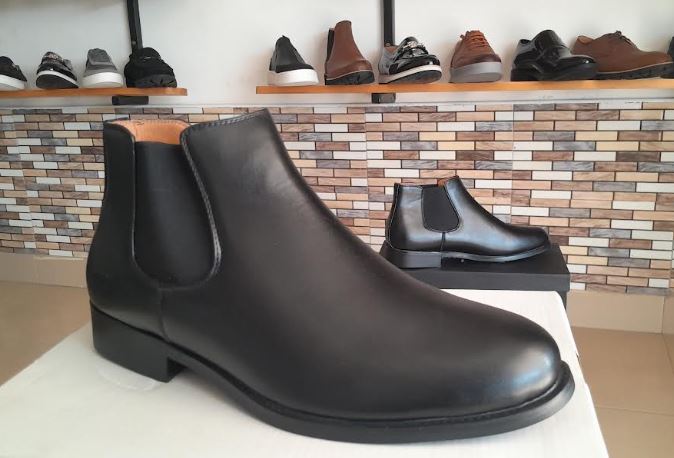
FAQs
What type of boots work best with suits?
Slim, ankle-high boots with polished leather and minimal detailing, such as Chelsea boots, work best with suits.
Are suede boots appropriate for the office?
Suede boots are appropriate in creative or smart-casual offices, especially when paired with textured or patterned outfits.
How do you match boot color with your work attire?
Use dark colors like black or brown for formal looks and lighter shades like tan for casual outfits with chinos or denim.
What’s the ideal pant fit for wearing office boots?
Choose slim or tailored pants that gently rest on the boot without clinging too tightly or bunching up.


